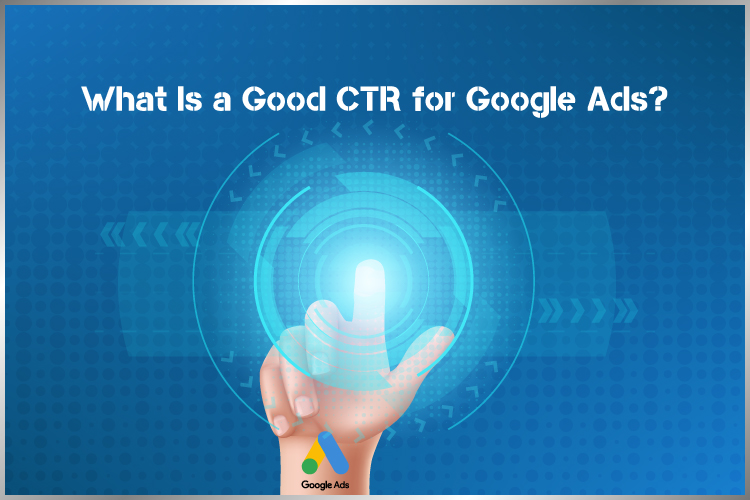What Is a Good CTR for Google Ads?

CTR or Click-Through Rate matters a lot for digital advertisers. In the majority of the PPC ad networks, such as Google Ads, Facebook Ads, and Bing Ads, the click-through rate helps in determining the ad rank as well as the cost-per-click of your ad. For example, in Google Adwords, the more your CTR is, the better your ad rank and the lesser your CPC will be.
Click-through rate tells the percentage of the total number of clicks your ad received divided by the total number of ad views. Google uses Quality Score to provide a general estimate of your overall ad quality and determine your ad position and actual CPC. While there are multiple factors impacting your ad Quality Score, Google considers CTR as a prime determinant.
What Is Considered a Good Click-Through Rate Then?
So now that we have discussed the importance of CTR for Google Ads, it brings us back to the question this blog topic poses – what is considered a good click-through rate?
Well, putting in simple words, it depends on the industry your business is in, the type of business organization you are running, and your goals, among various other factors.
However, if you are new to this PPC world and just getting started with it, you might want to use an online tool to find out if the current CTR of your Google Ads is more or less than the average click-through rate in your industry.
Average Click-Through Rates in Google Ads
It takes time to determine your ideal average CTR. Plus, it won’t be the same for everyone and varies due to multiple factors, including your type of business industry and the keywords you are using, and their competitiveness.
However, it is always good to have a few general guidelines to start your ad campaign.
With a little research, you will be able to find the average click-through rates in Google Ads across multiple industries. And thanks to the Internet, such data is just some clicks away from you.
Once you know the average CTR, needless to say, you should strive to beat those benchmarks because, well, a good click-through rate has to be “better” than the average. Moreover, studies also suggest that a higher CTR not only results in a higher Google Quality Score but also higher conversion rates.
If you feel curious about knowing your own click-through rate in Google Ads, you can sign in to your Google Ads account and click on the Ads & Extensions option available in the left menu on your screen. Then, you can check out your CTR and compare it to your competitors from the multiple columns displayed in the table.
I Know My CTR – What’s Next?
Let’s say you begin with these norms and decide to target a 4% CTR for your tour and travel company. You ascertain your target keywords, place bids on them, and set up your ad campaign and landing page with those keywords.
Now what?
For starters, let your ad run for a couple of weeks and then check its click-through rate. You can find this data available in your Google Ads account’s dashboard. Now see if your CTR has been able to achieve your goal or not.
If you find that your click-through rates are lower than your goals, take a look at your ad’s content. Is your ad emotional and appealing? Is your value proposition clear? Did you include your target keywords? Make your offering enticing and easy to understand; otherwise, your audience won’t even click on your ads in the first place.
Be sure to utilize ad extensions. They provide additional info about your ad or brand, expanding your ad’s size and boosting your CTR.
Apart from all this, keep in mind that it is possible for an advertiser to have a “too high” CTR. If your click-through rate is solid, but the conversion rate is poor, the chances are that you won’t be able to achieve a good ROI (return on investment). That’s simply because you will be paying for clicks that don’t convert. Therefore, to avoid a situation like this, ensure that what you are offering is something that your audience wants. Plus, optimize your landing page for conversions on all devices.
Once you have made the following changes to your ad, track your CTR and conversions closely to see the results. If your revenue is higher than what you spend on your ad clicks, consider chasing a higher CTR. The best ways to do this is by refining your ad content, selecting better niche keywords, and integrating negative keywords in your Google Ads campaign to prevent wastage of money. Taking these steps will help you acquire more qualified ad impressions, increase your CTR, and boost conversions.
Conclusion
By now, you must have got everything you needed to know – what CTR is, its importance, average CTR, how to measure CTR, and lastly, how to improve your CTR.
But as we wrap up, here are some bonus tips that you might want to consider when finding your ideal CTR for paid search:
- Generally, the CTRs for search ads are more than the CTRs for display ads. The reason is that the latter does not match the searcher intent as closely as the former, and display ads are typically more about building brand awareness and not generating instant conversions.
- Ads linked to “soft conversions,” such as a free quote, are more likely to achieve higher CTRs as compared to ads for big-ticket items such as electronics.
- Ads for branded keywords drive some of the highest click-through rates of all and can increase your overall Quality Score effectively.
So, that will be all. Keeping these benchmarks in mind, start your Google Ads campaigns. Implement the tips discussed above, and you will be all set to rule the ad world.
